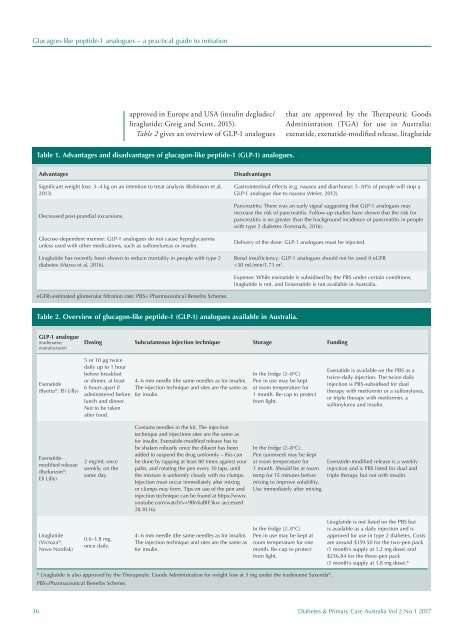DPCA2-1
You also want an ePaper? Increase the reach of your titles
YUMPU automatically turns print PDFs into web optimized ePapers that Google loves.
Glucagon-like peptide-1 analogues – a practical guide to initiation<br />
approved in Europe and USA (insulin degludec/<br />
liraglutide; Greig and Scott, 2015).<br />
Table 2 gives an overview of GLP-1 analogues<br />
that are approved by the Therapeutic Goods<br />
Administration (TGA) for use in Australia:<br />
exenatide, exenatide-modified release, liraglutide<br />
Table 1. Advantages and disadvantages of glucagon-like peptide-1 (GLP-1) analogues.<br />
Advantages<br />
Significant weight loss: 3–4 kg on an intention to treat analysis (Robinson et al,<br />
2013).<br />
Decreased post-prandial excursions.<br />
Glucose-dependent manner: GLP-1 analogues do not cause hypoglycaemia<br />
unless used with other medications, such as sulfonylureas or insulin.<br />
Liraglutide has recently been shown to reduce mortality in people with type 2<br />
diabetes (Marso et al, 2016).<br />
Disadvantages<br />
Gastrointestinal effects (e.g. nausea and diarrhoea): 5–10% of people will stop a<br />
GLP-1 analogue due to nausea (Meier, 2012).<br />
Pancreatitis: There was an early signal suggesting that GLP-1 analogues may<br />
increase the risk of pancreatitis. Follow-up studies have shown that the risk for<br />
pancreatitis is no greater than the background incidence of pancreatitis in people<br />
with type 2 diabetes (Forsmark, 2016).<br />
Delivery of the dose: GLP-1 analogues must be injected.<br />
Renal insufficiency: GLP-1 analogues should not be used if eGFR<br />
















